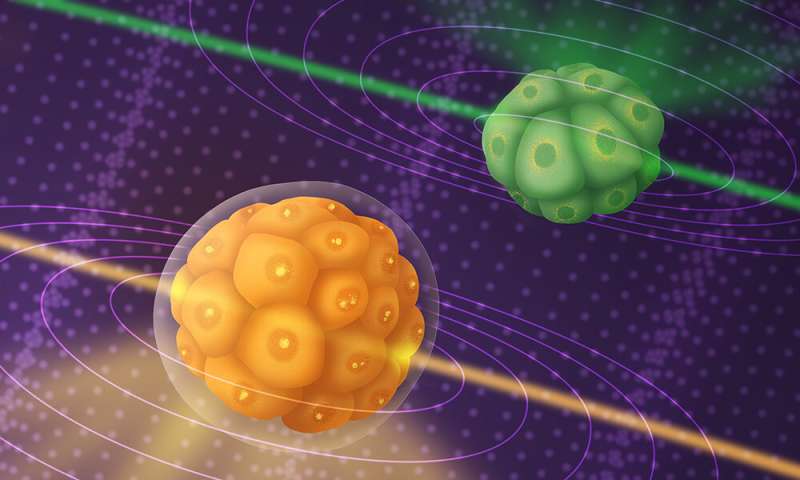This article has been reviewed according to Science X's editorial process and policies. Editors have highlighted the following attributes while ensuring the content's credibility:
fact-checked
peer-reviewed publication
trusted source
proofread
Shining a light on the mechanics of embryo development

In 1922, French physicist Léon Brillouin predicted an interesting phenomenon—when light is shone on a material, it interacts with the naturally occurring thermal vibrations within it, exchanging some energy in the process. This, in turn, influences how the light is scattered. By measuring the spectrum (color) of the scattered light, we can deduce certain physical characteristics of that material.
More than a century later, scientists from the Prevedel group at EMBL, along with their collaborators, have harnessed this phenomenon (called Brillouin scattering) to track the mechanical properties of developing embryos with unprecedented speed and resolution.
"We often tend to think of cells or tissues only in terms of their biological properties—which genes do they express? Which biochemical pathways do they rely on? What chemical signals do they send to each other?" said Robert Prevedel, Group Leader at EMBL Heidelberg. "However, cells and tissues also have rich 'mechanical' lives. And these physical properties can help determine their biological function."
The physical forces cells experience and their own material properties play a critical role in processes as diverse as embryonic development, tissue integrity, and the pathophysiology of diseases such as cancer. Two of these properties are viscosity—a measure of how easily a substance flows—and elasticity—a measure of how quickly a deformed object returns to its original state.
However, measuring these properties without damaging the cells and tissues can be challenging, as measurement methods often involve invasive approaches like "poking" or "probing" the samples in different ways. Here, as researchers have previously shown, microscopy based on Brillouin scattering can be useful for non-invasively viewing and assessing tissue mechanics.
Unfortunately, traditional Brillouin microscopy suffers from a few drawbacks. First, the speed of imaging is slow, since the method relies on collecting information from a single point on the sample at a time. Second, many biological tissues and cells are highly sensitive to light, and as a result, the long light exposures required in Brillouin microscopy can harm or deter the very processes that scientists wish to study.
In their new study published in Nature Methods, Prevedel and his colleagues describe a new microscopy method based on Brillouin scattering, that deals with the above challenges in innovative ways. Researchers in the Prevedel group are experts in developing advanced optical imaging techniques and pushing the frontiers of deep tissue microscopy.
As Carlo Bevilacqua, Ph.D. student in the Prevedel lab and first author of the study, explains, the new method, called line-scanning Brillouin microscopy (LSBM), provides three major advantages.
First, instead of collecting information from a single point at a time, the new microscope scans the sample using an entire line of light at a time, which increases the speed of imaging by at least a hundred times. Second, it uses a new optical geometry, near-infrared light, and a Rubidium cell to significantly increase the signal-to-noise ratio, providing better resolution and reducing the risk of light-induced damage to cells.
And third, by integrating this system with an advanced light-sheet microscope, scientists can simultaneously visualize biomolecules using fluorescence, and this information can be layered on top of the mechanical properties of tissues.
"I really like building things," said Bevilacqua. "Setting up a microscope like this involves quite a bit of theoretical optics knowledge, coupled with engineering and hands-on work, but you also require biological know-how."
As proof of principle, the scientists used their newly built microscope to study embryonic development in three animal species from different evolutionary branches of the tree of life—fruit flies, mice, and a marine organism called Phallusia mammillata. In all of these species, the new microscopy method allowed researchers to follow the dynamics of mechanical changes in developing embryos in three dimensions and over a time scale of many hours.
"Studying development like this, in real time and in the whole volume of tissues rather than just the surface, can reveal many new and interesting biological mechanisms," said Juan Manuel Gomez, postdoc in the Leptin and Prevedel lab and second author of the study.
The study involved collaborations with multiple other groups at EMBL, including the Ellenberg and Diz-Muñoz groups, as well as EMBL alumna Maria Leptin, formerly the director of EMBO and currently the European Research Council (ERC) President.
More information: Robert Prevedel, High-resolution line-scan Brillouin microscopy for live imaging of mechanical properties during embryo development, Nature Methods (2023). DOI: 10.1038/s41592-023-01822-1. www.nature.com/articles/s41592-023-01822-1
Journal information: Nature Methods
Provided by European Molecular Biology Laboratory





















